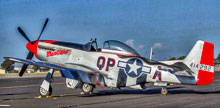B-25 Mitchell

The B-25 Mitchell was a twin-engined medium bomber manufactured by North American Aviation. Used by numerous Allied air forces around the world, it flew in every theater of World War II, was used by several other air forces after the war ended, and remained in active service for forty years.
A Brief History Of The B-25 Bomber
The B-25 Mitchell was a twin-engined medium bomber manufactured by North American Aviation. Used by numerous Allied air forces around the world, it flew in every theater of World War II, was used by several other air forces after the war ended, and remained in active service for forty years.
The B-25 was named after General Billy Mitchell, a U.S. military aviation pioneer. Nearly 10,000 B-25s in numerous models were built over the course of its production run.
The B-25 first gained notoriety as the bomber used in the Doolittle Raid of April 18, 1942. In that operation, 16 B-25s commanded by Lt. Colonel Jimmy Doolittle attacked mainland Japan, four months after the attack of Pearl Harbor. The mission was a vital morale-booster for America, and unnerved the Japanese, who had until then considered their home islands beyond the reach of enemy forces. Though the amount of actual damage inflicted by Doolittle was relatively minor, it forced the Japanese to divert troops for homeland defense for the rest of the war.
In addition to being a very safe airplane to fly, the B-25 was a stupendously sturdy aircraft able to withstand terrible enemy punishment. One particularly striking example of this was a B-25C of the 321st Bomb Group, which was nicknamed “Patches” because its crew chief painted all the aircraft’s flak hole patches with high-visibility zinc chromate primer. By the end of the war, “Patches” had flown over 300 missions, was belly-landed six times, and had managed to collect over 400 patched holes.
By the time the US Air Force was established in 1947, most B-25s had been relegated to long-term storage. A select number remained in service through the late 1940s and 1950s however, in a variety of training, recon, and support roles.
|
Specifications |
|
|
Role |
Medium bomber |
|
Manufacturer |
North American Aviation |
|
Designer |
North American Aviation |
|
First flight |
August 19, 1940 |
|
Propulsion |
|
|
Twin-engine |
Wright R-2600-92 14-cylinder air-cooled radial engine |
|
Performance |
|
|
Max speed |
272 mph at 13,000 ft |
|
Max cruising speed |
230 mph |
|
Service ceiling |
24,200 ft |
|
Max range (external tanks) |
1,350 miles |
|
Weight (empty) |
19,480 lbs |
|
Max takeoff |
35,000 lbs |
|
Dimensions |
|
|
Wing span |
67 ft 7 in |
|
Length |
52 ft 11 in |
|
Height |
16 ft 4 in |
|
Wing area |
610 sq ft |
|
Seating Capacity |
6 |
|
Armament |
|
|
Guns |
12–18 × .50 in (12.7 mm) machine guns |
|
Hardpoints |
2,000 lb (900 kg) ventral shackles to hold one |
|
Rockets |
Racks for eight 5 in (130 mm) high velocity |
|
Bombs |
3,000 lb (1,360 kg) bombs |




































